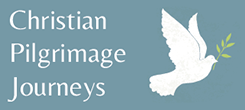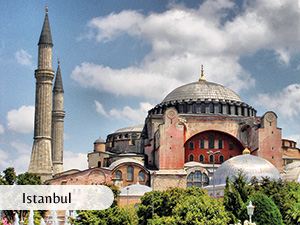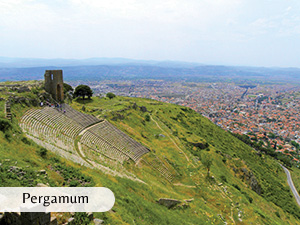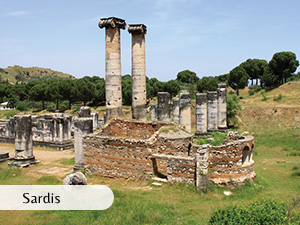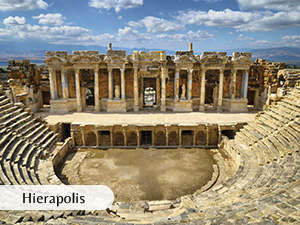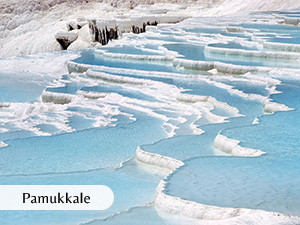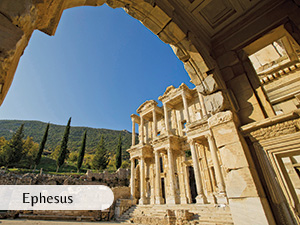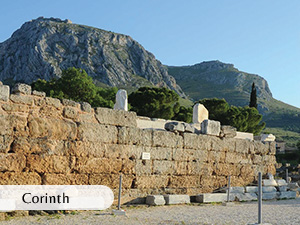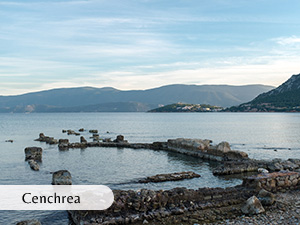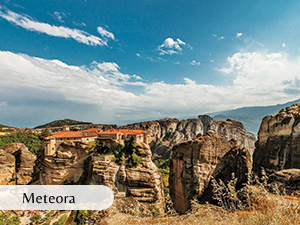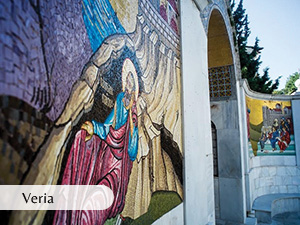
The Seven Churches Of Revelation & The Steps Of Paul In Greece
A 15 Days / 14 Nights Christian Tour In Greece & Turkey
Itinerary
Day 1, Saturday: Istanbul
Arrival in Istanbul where we will meet up at the airport and transfer you to your hotel. Rest of the day is at leisure, dinner and overnight in Istanbul.
Day 2, Sunday: Istanbul
Breakfast and full-day city tour of Istanbul. Visits include monuments of the Ottoman and Byzantine Empire, the Roman Hippodrome, Hagia Sophia, Blue Mosque, Topkapi Palace and the Grand Bazaar with over 4000 shops. Lunch will follow at a local restaurant and we will return at dusk. Dinner and overnight in Istanbul.
Day 3, Monday: Istanbul / Troy / Canakkale
Breakfast and visit to the legendary city of Troy, whose fame derives from Homer’s Iliad and the Trojan War and after we will continue to Canakkale for dinner and overnight.
Day 4, Tuesday: Canakkale / Pergamum / Thyatira / Izmir
Breakfast and departure from Canakkale to explore three of the cities that received the letters of John: - Pergamum (Revelation 2: 12-17), now called Bergama, was the rival city of Alexandria in the arts and letters. On a visit to this
city we will see its Greco-Roman Theatre, the Temple of Trajan and altar of Zeus. The Pergamum church characterizes the
church from the time of Constantine (313-600 AD). At that time Christianity became the official religion of the Roman state. In
this way, the church began to spread around the world.
- Thyatira (Revelation 2: 18-29), which was an important trade center in ancient times, is now called Akrisar meaning White
Castle. A letter to this Church was the longest of all the letters of the Apocalypse and the message it delivers is also among the
toughest. We will have lunch at a local restaurant, return in the evening for dinner and spend the night there.
- Izmir (Revelation 2: 8-11), at the time it was called Smyrna, which means bitter. The origin of the word Smyrna derives
from «myrrh», which was one of the components that served to embalm the dead (John 19:39). In this city, we will enjoy a
panoramic visit and then visit the church of St. Polycarp. We will gather for dinner and spend the night there.
Day 5, Wednesday: Izmir / Sardis / Philadelphia / Pamukkale
Breakfast and set off for the city of Sardis (Revelation 3:1-6), whose ruins bear near the present village of Sarte and Philadelphia (Revelation 3: 7-13). There, we will visit their respective churches. Philadelphia lies in a valley at the foot of a mountain plateau. The location of the city is now occupied by a small Turkish village name Shehr Allah, meaning “city of God”. Pamukkale is one of the most breathtaking places in the world, stunning for its white waterfalls and natural swimming pools, where will indulge in its beauty. The day will conclude with dinner and we will stay overnight.
Day 6, Thursday: Pamukkale / Hierapolis / Laodicea / Kusadasi
Breakfast and visit to the ancient city of Hierapolis. We will continue to Laodicea (Revelation 3: 14-22) that was located at the site of the modern city of Denizli, where we will visit one of the seven churches. The hot springs of Hierapolis, mentioned by Paul in his letter to the Colossians (Col 4:13), meaning “Holy City”, a UNESCO world heritage site, classified for its hot springs and the ruins of the ancient capital of Phrygia, where Saint Philip is buried and Colossus (now known as the village of Honaz), whose church was mentioned in the Epistle to the Colossians. The hot springs of Hierapolis helped in the treatment of health problems, while the cold waters of Colossi were good to drink. Then we will move to Kusadasi where we will enjoy dinner and spend overnight.
Day 7, Friday: Kusadasi / Ephesus
Breakfast and move to Ephesus. Ancient Ephesus was the Roman capital of Asia Minor and an important center for Christianity from AD 50s. During AD52-54 Saint Paul lived here working with the congregation and organizing his missionary activity and taught the Word of God (Acts 20:31) and this is where he wrote the Epistle to Corinthians I. Additionally this was one of the seven cities found in the Book of Revelation(Acts 2:1-7), indicating a strong church. We will visit the house of Virgin Mary where she lived with John, on the hill behind the city. After this amazing experience we will have lunch and then visit the Basilica of St. John as well as the ruins of the famous Diana’s temple with the Baths of Scholastica, the Library of Celsus, theOdeon, the Arch of Hercules, the Temple of Hadrian, the Agora and the Greco-Roman theater. The day will conclude with dinner and we will stay overnight.
Day 8, Saturday: Kusadasi/ Patmos
Breakfast and move to the port to board the cruise to the Greek islands. Over lunch, the ship will head to the island of Patmos, a beautiful and spiritual island where in 95 AD, St. John the Theologian - one of the twelve disciples of Jesus - was sent into exile. St. John remained on the island for eighteen months during which time he lived in a cave below the hilltop temple of Diana. In this cave exists a small hole in the rock wall, from which derived a series of oracular messages that Prochoros, a disciple of St. John, transcribed as the Biblical chapter of Revelations. During his time in the sacred cave, now known as the Holy Grotto of the Revelation, St. John also composed the Fourth Gospel. During our time there we will visit the Monastery of St. John the Theologian UNESCO World Heritage Site where we will see the Holy Grotto as well as priceless icons and manuscripts.
Day 9, Sunday: Heraklion (Crete) / Santorini
In the morning the ship will dock at the port of Heraklion on the island of Crete. In Heraklion Paul met the owner and captain of the ship, who warned him about continuing his journey to Rome. You can take a tour (optional) to the Palace of Knossos, the center of the Minoan civilization. After lunch, the ship will travel to the most beautiful island in the Aegean Sea known as the “Black Pearl of the Aegean”, the volcanic Santorini where we will enjoy the breathtaking Panoramic View. Latest excavations have suggested that Santorini might be the lost sight of Atlantis.
Day 10, Monday: Piraeus (disembarkation) / Corinth / Cenchrea / Athens City Tour
Breakfast on board and early arrival in Piraeus. After disembarking, we will head toward ancient Corinth (Acts 18.1-18). It was in ancient Corinth where Paul came and worked, established a thriving church and writing two of the epistles, which are now part of the New Testament. We will see all the sites that are associated with his ministry: the Agora, the Temple of Apollo, the roman Odeon, the Bema and Gallio’s seat, the pillars, stairs, and the place of public worship, where Paul preached. All these visits will certainly enhance the understanding of Corinthians I and II. Before ending the tour and return to Athens, we will visit the ancient Greek port of Cenchrea (Acts 18:18) where Paul was during his second missionary journey and the ruin of the early Christian 5th Century basilica. Next stop will be Athens where we will have city tour visiting the main points of interest in town: the Acropolis, the Parthenon and the Areopagus where Paul preached the Truth to the nation (Acts 17:22). Dinner and overnight in Athens.
Day 11, Tuesday: Athens / Delphi/ Kalambaka
We will have breakfast and then departure towards Delphi. Delphi is the famous oracle where the priestess of Apollo, Pitia, influenced, with their prophecies the history of cities and states of antiquity. Visit the archaeological site and museum. The museum houses an impressive collection associated with ancient Delphi, including the earliest known notation of a melody, the famous Charioteer, golden treasures discovered beneath the Sacred Way, and fragments of reliefs from the Siphnian Treasury. Close to the exit is the inscription that mentions the Roman proconsul Gallio. The reference to proconsul Gallio in the inscription provides an important marker for developing a chronology of the life of Apostle Paul by relating it to the trial of Paul in Achaea mentioned in the Acts of the Apostles (18:12-17). Near there you will find the famous Monastery of Hosios Loukas. This is a historic walled monastery and one of the most important monuments of Middle Byzantine architecture and art, and has been listed on UNESCO’s World Heritage Sites. The trip continues with a visit to Kalambaka for dinner and overnight.
Day 12, Wednesday: Kalambaka/Meteora / Veria / Vergina / Thessalonica
Following breakfast we will visit the spectacular Meteora, the UNESCO World Heritage Site, which is a mountainous region of stunning scenery. You will see hundred-year-old Byzantine monasteries on top of huge rocks, during the Middle Ages, first built in the 14th century by monks seeking isolation and salvation. We will visit the most famous of them, which is now a popular museum, the Great Meteoron, to admire superb icons, old manuscripts, unique mosaics and frescoes. Departure to Veria (Berea), another town evangelized by Paul (Acts 17.10-14). When Saint Paul visited this town in AD50, he came across a more “noble” Jewish community where he preached and created an important Church. This is where Paul met Sopatros, who would later become a valuable comrade who followed him on his return journey to Asia. We will visit the ancient synagogue where we will see the Byzantine mosaic in the monument commemorating his preaching. According to tradition it was at this place where he preached. Then we will head to Vergina, the legendary burial site of the Macedonian kings. This place is considered as a World Heritage Site, also known as the Royal Tombs and houses the tomb of King Philip II, father of Alexander the Great and conqueror of Greek territories which resulted in the expansion of Hellenism. Return to Thessalonica, dinner and overnight.
Day 13, Thursday: Thessalonica / Philippi / Kavala / Thessalonica
The day will begin with a trip to Philippi, the town where Paul delivered his first sermon in Europe, sowing the seeds of Christianity. “And from there (He went) to Philippi, which is the leading city of the district of Macedonia and a Roman Colony. We remained in this city some days...” (Acts 16:12- 18). Paul arrived here with Silas and Luke on the winter of AD 49 to AD50. There the first Christian baptism was performed, of a woman named Lydia. Although they were prosecuted and arrested, they received God’s help to escape from prison (Acts 16: 11-23) where there was the conversion of the jailer (Acts 16: 23-26). We will visit the Roman Theatre, probable site of the prison where Paul and Silas were arrested. We will continue towards the city of Kavala and the ancient city of Neapolis (Acts 16:11) where Paul landed with his disciples, Timothy and Silas. It was later renamed Christoupolis, meaning city of God, because it was the first European city to accept Christianity. We will visit the Roman Aqueduct and the ruins of the Acropolis. Dinner and overnight in Thessalonica.
Day 14, Friday: Thessalonica / Athens
Breakfast and return to Athens. On the way we will see the walls of the Old Town, the newly excavated Forum, an ancient Roman monument that was transformed into a church and the Arch of Galerius, which rises along the famous Via Egnatia and we will also pass through Thermopylae, where we will see the statue of the Spartan King Leonidas. This place was an important and vital point because of its location. Several battles occurred there during the ancient time and the most famous was the heroic battle of the Spartans against the Persians in 480 BC. Arrival in Athens is expected in the afternoon where we will enjoy dinner and spend the night.
Day 15, Saturday: Athens Airport
According to the schedule of your return flight you will be taken to the airport of Athens.
Biblical Readings
I was in the Spirit on the Lord’s day, and heard behind me a great voice, as of a trumpet, saying, I am Alpha and Omega, the first and the last: and, What thou seest, write in a book, and send it unto the seven churches which are in Asia; unto Ephesus, and unto Smyrna, and unto Pergamos, and unto Thyatira, and unto Sardis, and unto Philadelphia, and unto Laodicea. Revelation 1:10,11
I John, who also am your brother, and companion in tribulation, and in the kingdom and patience of Jesus Christ, was in the isle that is called Patmos, for the word of God, and for the testimony of Jesus Christ. Revelation 1:9
Paul, called to be an apostle of Jesus Christ through the will of God, and Sosthenes our brother, Unto the church of God which is at Corinth, to them that are sanctified in Christ Jesus, called to be saints, with all that in every place call upon the name of Jesus Christ our Lord, both theirs and ours Grace be unto you, and peace, from God our Father, and from the Lord Jesus Christ. 1 Corinthians 1:1,2,3
Then all the Greeks took Sosthenes, the chief ruler of the synagogue, and beat him before the judgment seat. And Gallio cared for none of those things. And Paul after this tarried there yet a good while, and then took his leave of the brethren, and sailed thence into Syria, and with him Priscilla and Aquila; having shorn his head in Cenchreae: for he had a vow. Acts 18:17,18
And after he had seen the vision, immediately we endeavored to go into Macedonia, assuredly gathering that the Lord had called us for to preach the gospel unto them. Therefore loosing from Troas, we came with a straight course to Samothracia, and the next day to Neapolis; and from thence to Philippi, which is the chief city of that part of Macedonia, and a colony: and we were in that city abiding certaindays. Acts 16:10,11,12

